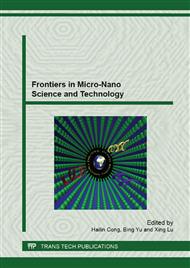p.36
p.41
p.46
p.52
p.57
p.61
p.65
p.69
p.73
Synthesis and Hydrogen Absorption Capacity of Multilayered SnO2 Hollow Microspheres
Abstract:
Multilayered SnO2 hollow microspheres (MHS-SnO2) have been successfully synthesized via a solvothermal method by using glycol-water as solvent. The morphology, composition and structure of the product have been characterized by field-emission scanning electron microscopy (FESEM) with an energy dispersive X-ray (EDX) spectroscopy, transmission electron microscopy (TEM), high-resolution transmission electron microscopy (HRTEM) with selected area electron diffraction (SAED) and X-ray diffraction (XRD). The FESEM, TEM and HRTEM images indicate that the as-prepared microspheres show multilayered structure and the wall of the hollow microspheres is composed of single crystalline nanoparticles. Study on hydrogen absorption characteristics of MHS-SnO2 performed at 373 K shows a good absorption capacity of 0.85 wt.%.
Info:
Periodical:
Pages:
57-60
Citation:
Online since:
April 2014
Keywords:
Price:
Сopyright:
© 2014 Trans Tech Publications Ltd. All Rights Reserved
Share:
Citation:


